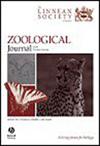An enduring palaeontological riddle: how many hippopotamid species roamed Sicily? The case study of Amoroso Cave
IF 2.8
2区 生物学
Q1 ZOOLOGY
引用次数: 0
Abstract
Hippopotamus pentlandi, although lacking a comprehensive description, is regarded as one of the best known dwarfed hippopotamid species within the Mediterranean region. This study provides a detailed analysis of a hippopotamus mandible from Amoroso Cave (Palermo, Sicily). Morphological and morphometric comparisons with insular and continental species reveal a significant similarity between the Amoroso mandible and some specimens from San Ciro Cave (Palermo, Sicily), as well as with Hippopotamus amphibius. Conversely, material from Cannita Cave (Palermo, Sicily) attributed to H. pentlandi is less robust, more elongated and smaller. 3D geometric morphometric analysis performed on the symphyseal sagittal cross-section further support a closer morphological affinity of the Amoroso mandible to San Ciro Cave specimens and H. amphibius, suggesting an attribution to the latter. Our research reveals the presence of at least two different, potentially coeval, taxa in the Pleistocene of Sicily: the dwarfed Hippopotamus pentlandi primarily known from Cannita Cave, and H. amphibius. While Cannita Cave material has been thoroughly studied over the years, abundant remains from other localities, e.g. San Ciro Cave, require re-evaluation. A thorough analysis of Sicilian hippopotamids is crucial to improve our understanding of their systematics and to provide new insights into the palaeobiogeography, palaeobiology, and palaeoenvironment of Sicily during the Pleistocene.一个经久不衰的古生物之谜:西西里岛上有多少种河马?阿莫罗索洞穴的案例研究
虽然缺乏全面的描述,但它被认为是地中海地区最著名的侏儒河马之一。本文对西西里岛巴勒莫阿莫罗索洞穴中一只河马的下颌骨进行了详细的分析。与岛屿和大陆物种的形态学和形态计量学比较表明,阿莫罗索的下颌骨与圣西罗洞穴(Palermo,西西里岛)的一些标本以及与两栖河马(Hippopotamus amphibius)之间存在显著的相似性。相反,来自坎尼塔洞穴(Palermo,西西里岛)的材料被认为是H. pentlandi的材料不那么坚固,更细长,更小。三维几何形态测量分析进一步支持阿莫罗索下颌骨与圣西罗洞穴标本和两栖人在形态上更接近,表明其属于后者。我们的研究揭示了西西里岛更新世至少存在两种不同的、可能是同一时期的类群:主要来自卡尼塔洞穴的侏儒河马(Hippopotamus pentlandi)和两栖人。虽然坎尼塔洞穴的材料已经被彻底研究了多年,但其他地方的大量遗迹,如圣西罗洞穴,需要重新评估。对西西里岛河马的深入分析对于提高我们对其系统分类学的认识,并为西西里岛更新世时期的古生物地理、古生物学和古环境提供新的见解至关重要。
本文章由计算机程序翻译,如有差异,请以英文原文为准。
求助全文
约1分钟内获得全文
求助全文
来源期刊
CiteScore
6.50
自引率
10.70%
发文量
116
审稿时长
6-12 weeks
期刊介绍:
The Zoological Journal of the Linnean Society publishes papers on systematic and evolutionary zoology and comparative, functional and other studies where relevant to these areas. Studies of extinct as well as living animals are included. Reviews are also published; these may be invited by the Editorial Board, but uninvited reviews may also be considered. The Zoological Journal also has a wide circulation amongst zoologists and although narrowly specialized papers are not excluded, potential authors should bear that readership in mind.

 求助内容:
求助内容: 应助结果提醒方式:
应助结果提醒方式:


